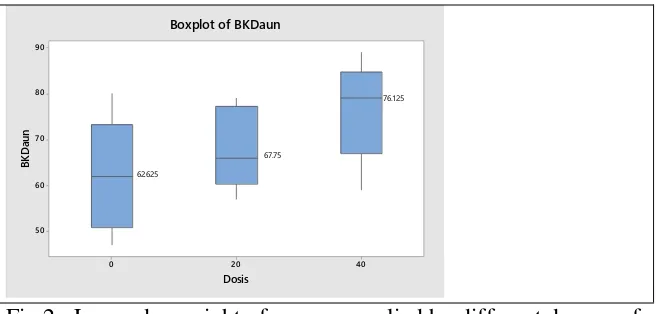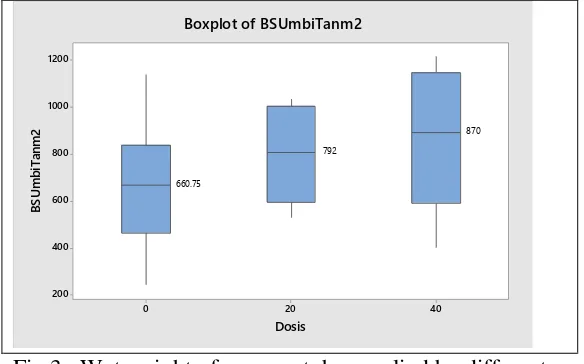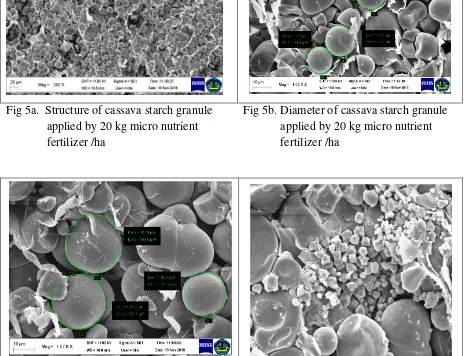different micro nutrient fertilizer levels by using scanning electronic microscopy (SEM) and Real Time PCR
Kukuh Setiawan1), Paul B TImotiwu1), Agustansyah1), M. Syamsoel Hadi1), Ardian1), and Wawan A Setiawan2)
1) Researchers of Department of Agriculture and Horticulture, College of Agriculture, University of Lampung
2) Researchers of Department of Biology, College of Mathematics and Sciences, University of Lampung
Abstract
The objectives of this study were to evaluate vegetative growth and root storage of cassava applied by micro nutrient fertilizer, to compare root storage of yield treated by micro nutrient fertilizer as 0, 20, and 40 kg/ha, to evaluate the structure of cassava starch by using Scanning Electron Microscopy (SEM), and to identify the activity of gene starch synthase with Real Time PCR. There were three different dosages of micro nutrient fertilizer as 0, 20, and 40 kg/ha. Variables observe in this study were leaf number, leaf dry weight, storage root number, storage root wet weight, diameter of starch granule, visual starch granule by SEM, and gene starch synthase activity by Real Time PCR. The result showed that leaf number of cassava applied by high dosages of micro nutrient fertilizer (20 & 40 kg/ha) tended to be lower compared to those without micro nutrient fertilizer application. Yet, the application of high dosages of micro nutrient fertilizer, tended to produce relatively high leaf dry weight. Such condition could support the production of high storage root number and weight. Additionally, starch structure applied by high dosages of micro nutrient fertilizer seemed to be denser due probably to high starch granule diameter. The increase in storage root number and density of cassava applied by 20 kg micro nutrient fertilizer/ha was concomitant with high gene starch synthase activity, approximately as many as 200 times compared to those without micro nutrient fertilizer application.
Keywords: micro nutrient fertilizer, Real Time PCR, starch granule, starch synthase Introduction
reduce the quality of starch especially decrease in granule density as well as starch content. Based on the habitual farmers, they usually harvest cassava before 7-8 MAP or less than 12 MAP. The other problem is farmers are very rare to fertilize cassava plant with micro nutrient fertilizer. To increase storage root yield, Cock et.al. (1979) informed that population of 20.000 plants/ha with optimum control of pest and disease, cassava storage root yield would be up to 30 metric ton/ha at 12 MAP. Additionally, early planting and late planting could influence cassava storage root yield. Agbaje dan Akinlosotu (2004) concluded that cassava storage root yield was 44t /ha harvested at early planting and 31 t/ha at late planting. Study on the application of micro nutrient combined with macro nutrient fertilizers to increase cassava starch yield was conducted by Panitnok et al. (2013). They showed that in Thailand, fresh weight of storage root and starch content would increase up to 29% when cassava is applied by Zn. Moreover, in Indonesia Hadi (2010) gave information that application of micro nutrient could increase fresh weight of storage root (yield increment of 0.47 kg) when early harvested at 210 DAP.
According to (Zhu, 2014), cassava starch has finer surface than potato starch and the more cassava age to be harvested the more clearly granule distribution. It seems that starch cassava would increase as cassava is harvested at 12 MAP. Consequently, the clear distribution would increase starch content if harvested at 12 MAP. Miao et al. (2014) conducted study the gene starch synthase (GSS) in banana. They concluded that activity of GSS would increase gradually as the growth of banana fruit was developing.
You-Zhi et al. (2015) reported that there were four questions from scientist due mainly to limited proof from research result as whether high starch accumulation in storage root related to strong capacity of transport from stem part, whether high starch accumulation in storage root as a result of low efficient of starch degradation, whether simple sugar move via transportation far distance from stem, whether only simple sugar transport correlate with the ability of starch accumulation in part of storage root.
The objectives of this study were to vegetative growth and root storage of cassava applied by micro nutrient fertilizer, to compare root storage of yield treated by micro nutrient fertilizer as 0, 20, and 40 kg/ha, to evaluate the structure of cassava starch by using Scanning Electron Microscopy (SEM), and to identify the activity of gene starch synthase with Real Time PCR.
Material and Method
This study was conducted on dry land of Central Lampung from February to December 2016. The planting date was in March 2016 using variety cassava of Thailand (UJ3). Fertilizers used in this study were 200 kg urea/ha, 100 kg SP-36/ha, and 200 kg KCl/ha. These fertilizer were applied at 30 days after planting (DAP), urea was split into two parts of application, first was 30 DAP and second was 120 DAP. The application of micro nutrient fertilizer was at 120 days after planting (DAP) together with the application of second urea with the dosage of 0,20, and 40 kg/ha.
The activity of gene starch synthase of storage root sampled from 0 and 20 kg micro nutrient fertilizer/ha based on quantity of transcription of gene starch synthase IV by using Real Time PCR. Fresh storage root from cassava treated with 0 and 20 kg micro nutrient fertilizer/ha was aseptically taken approximately 0,2 g then put in the solution of RNA-later to protect RNA from contamination during the process of sampling until in laboratory. The extraction of RNA was conducted by the method of trizol. After getting the RNA total, synthetic of cDNA was analyzed by using RevertAidTM First-Strand cDNA Synthesis kit from Fermentas Co. Moreover, the design of primer for gene starch synthase was based on gene starch synthase of type IV with access code of starch synthase KT033500.1. cDNA. Then
each quantity of gene starch synthase type IV was determined by Real Time.
Result and Discussion
The leaf number and leaf dry weight tended to be influenced by micro nutrient fertilizer. Leaf number tended to be decreased as the application dosage of micro nutrient fertilizer increased (Fig 1) yet not significantly different (Table 1). Interestingly, leaf dry weight would increase as the application dosage of micro nutrient fertilizer increased (Fig 2). It seems that micro nutrient fertilizer induces and increases the photoassimilate as a source. The average of leaf dry weight per plant of cassava without application of micro nutrient fertilizer was 62.6 g and would reach up to 67.8 g at 20 kg/ha then to be 76.1 g at 40 kg/ha. Two factors would affect starch yield of cassava as storage root wet weight and starch content. Starch content could be influenced by quality of starch granule especially granule size (diameter). The application of 40 kg micro nutrient fertilizer/ha would increase storage root number from 4.25 to 6.63 (Table 2.
micro nutrient fertilizer is less dense than those of 20 kg. Interestingly, application of 40 kg micro nutrient fertilizer seems much denser than those of 20 kg/ha (Fig. 6a,b). The diameter range of application of 40 kg micro nutrient fertilizer/ha was 20.30 – 26.79 µm. Between starch granules under application of 40 kg micro nutrient fertilizer, there is “filler” and this does not exist in both treatment of 0 and 20 kg micro nutrient fertilizer. Such condition might cause the increase in starch content due mainly to high dense granule.
The expression of starch synthase gene activity on the storage root of cassava treated by 20 kg micro nutrient fertilizer at 190 DAP showed as many 200 times as that of 0 kg micro nutrient fertilizer (Fig. 7). It proves that micro nutrient fertilizer application absolutely affects the increase in starch content by increasing high dense of granule starch. This could be proposed the mechanism of high quality cassava starch by application of micro nutrient fertilizer (Fig 8). The application of micro nutrient fertilizer increased expression of starch synthase gene resulting in the increase of photosynthate as a source (leaf dry weight). Such source would transport to storage root as a sink part, resulted in heavier storage root. On the other side, starch quality as granule enlarges the diameter lead to the much denser of granule starch. Both of heavier storage root and high dense of granule could probably increase the starch content.
Conclusion
Based on result and discussion, it could be concluded that:
a. The application of micro nutrient fertilizer tended to decrease leaf number however, leaf dry weight tended to be increased by application of micro nutrient fertilizer at 190 DAP.
b. Storage root number would be increased by application of micro nutrient fertilizer. However, the application of micro nutrient fertilizer did not signifantly increase storage root wet weight.
c. Starch granule diameter of cassava generally bigger under application of high micro nutrient fertilizer than that of no micro nutrient fertilizer. Especially, the application
of 40 kg micro nutrient fertilizer seems to induce “filler” resulted in high density of
d. The application of 20 kg micro nutrient fertilizer could induce the expression of high gene starch synthase as many as 200 times compared to no application of micro nutrient fertilizer.
Acknowledgements
We would like to thank to LPPM, University of Lampung giving opportunity to conduct the valuable research to characterize and identify cassava starch both physically (SEM) and genetically (PCR Real Time). Respectful appreciation is also addressed to Mr. Subadi (cassava farmer), students (University of Lampung and Sekolah Tinggi Pertanian Surya Dharma Bandar Lampung for their help and support in maintaining, recording, and harvesting. Collaboration and cooperation with Integrated Laboratory of University of Lampung (chairman and technicians) are also highly appreciated for the success of Scanning Electron Microscope (SEM) and PCR Real Time analysis.
References varieties in relation to time of planting. Bangladesh J. Bot. 34(1): 21-26.
Beyene, D., Y. Baguma, S.B. Mukasa, C. Sun, and C. Jansson. 2010. Characterisation and role of ISOAMYLASE1 (MEISA1) gene in cassava. African Crop Science Journal 18(1): 1 – 8.
BPS. 2015. Produksi Ubikayu Menurut Provinsi (ton), 1993-2015 (https://www.bps.go.id/linkTableDinamis/view/id/880).
Cock, J.H., D. Franklin, G. Sandoval, and P. Juri. 1979. The ideal cassava plant for maximum yield. Crop Sci.19: 271-279.
Dos Santos, N.S., J. M. A.Alves, S.C.P.Uchôa, N.T. de Oliveira, J. de Anchieta Alves de Albuquerque. 2014. Absorption of macronutrients by cassava in different harvest dates and dosages of nitrogen. Revista Ciência Agronômica 45(4): 633-640. Fageria, N.K. 2009. The Use of Nutrients in Crop Plants. CRC Press Taylor and Francis
Group. 430pp.
Hadi, M.S. 2010. Pengaruh Frekuensi Aplikasi Hara MikroTerhadap Produksi Ubi kayu di Blambangan, Way Kanan. Pros. Sem. Nas. Sains MIPA dan Aplikasinya, Bandar Lampung 8-9 Desember 2010.p20-25.
Howeler, R.H. 2001. Nutrient inputs and losses in cassava-based cropping
systems-examples from Vietnam and Thailand. International Workshop on Nutrient Balances for Sustainable Agricultural Production and Natural Resource Management in
Southeast Asia. Bangkok, Thailand, 20-22 February, 2001.
Munyikwa, T.R.I., S. Langeveld, S.N.I.M. Salehuzzaman, E. Jacobsen, and R.G.F. Visser. 1997. Cassava starch biosynthesis: new avenues for modifying starch quantity and quality. Euphytica 96: 65–75.
Panitnok, K., S. Chaisri, Ed Sarobol, S. Ngamprasitthi, P. Chaisri, P. Changlek, and P. Thongluang. 2013. The combination effects of Zinc, Magnesium, Sulphur foliar fertilizer management on cassava growth and yield grown on Map Bon, coarse-loamy variant Soil. Procedia - Social and Behavioral Sciences. 91: 288 – 293.
Salehuzzaman, S.N.I.M., E. Jacobsen, and R.G.F. Visser. 1993. Isolation and
characterization of a eDNA encoding granule-bound starch synthase in cassava (Manihot esculenta Crantz) and its antisense expression in potato. Plant Molecular Biology 23: 947-962.
You-Zhi Li, Jian-Yu Zhao, San-Min Wu, Xian-Wei Fan, Xing-Lu Luo, and Bao-Shan Chen. 2015. Characters related to higher starch accumulation in cassava storage roots Scientific Reports | 6:19823 | DOI: 10.1038/srep19823.
Zhu, F. 2014. Composition, structure, physicochemical properties, and modifications of cassava starch. Carbohydrate Polymers. 122: 456–480.
40
Fig 1. Leave number of cassava applied by different dosage of micro nutrient fertilizer
Table 1. Value of mean square, general means, and probability of observed variables
No Variables Mean square value General
means Probability Significantly different if P < 0,05 and not significantly different if P > 0,05.
Table 2. Leave number, leave dry weight, tuber number, and wet tuber weight of cassava applied by different dosage of micro nutrient fertilizer as, 0, 20, dan 40 kg/ha. No. Variable Dosage of micro nutrient fertilizer kg/ha
0 20 40
1. Leave number (piece) 49,3a 41,3a 41,0a
2. Leave dry weight (g) 62,6a 67,8ab 76,1b
3. Tuber number (no) 4,25a 5,38ab 6,63b
4. Wet tuber weight (g) 661a 792a 870a
Number in the same column followed by the same letter indicated not significantly difference
under Tukey’s procedure in the level of 5%
Fig 4a. Structure of cassava starch granule applied by 0 kg micro nutrient fertilizer /ha
Fig 4b. Diameter of cassava starch granule applied by 0 kg micro nutrient fertilizer /ha
Fig 5a. Structure of cassava starch granule applied by 20 kg micro nutrient fertilizer /ha
Fig 6a. Diameter of cassava starch granule applied by 40 kg micro nutrient fertilizer /ha
Fig 6b. “Filler” between starch granule applied by 40 kg micro nutrient fertilizer per ha
Fig 7. Expression of gene starch synthase in the cassava tuber harvested at 190 DAP.



